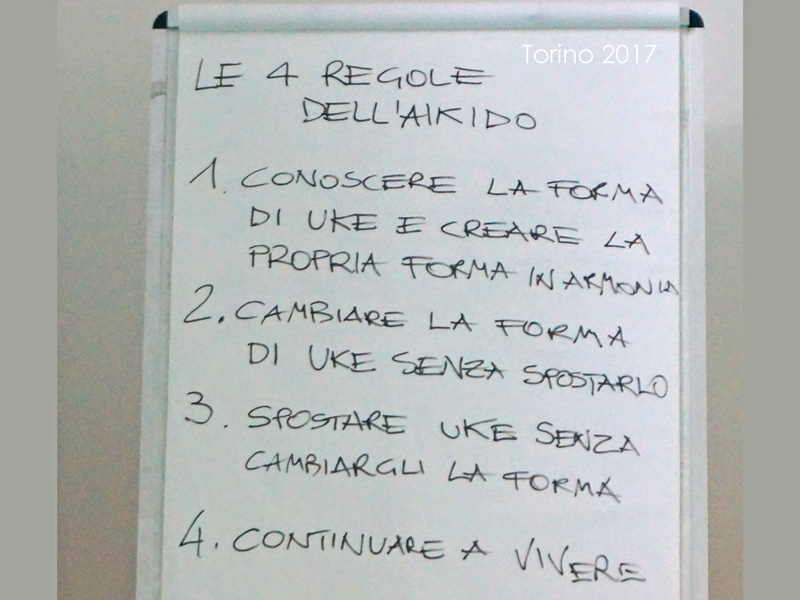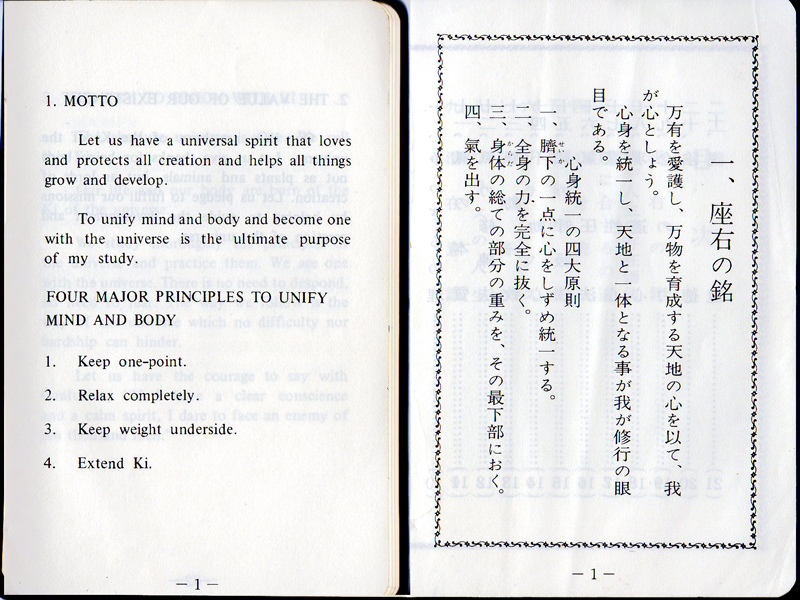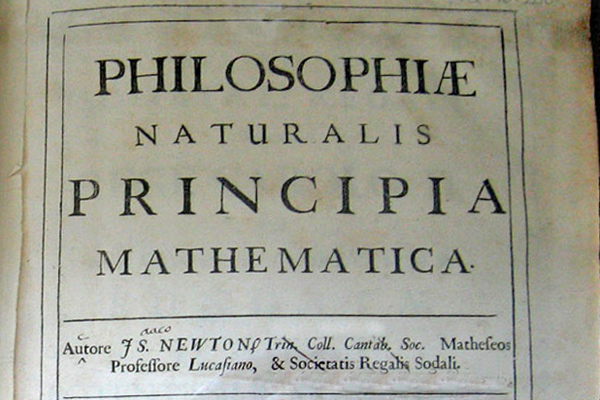Principles
Yoshigasaki Sensei questions Tohei Sensei's four basic principles.
2021-11-07
Yoshigasaki Sensei questions Tohei Sensei's four basic principles.
Summary:
00:00
... So, I'll just call it "four basic techniques".
Keep one point, relax completely, weight underside, extend Ki.
They are not principles, but basic techniques. That is the change. Why? Principles are still material theory. There are no principles in life. What is a principle? In fact, principles were a way to understand the material world. Why? Imagine the world two thousand, three thousand years ago. What was important? Material was important. Life was not very important. Why? Because life was abundant. Three thousand, four thousand years ago: too much life and not enough material.
01:00
So this means that first the material was very important. Life was not very important. That is why all scholars have studied materials. Therefore, the principles (laws of nature) served to better understand the material world. Today, material theory has been developed quite much. Now we have to understand life. That is the difference.
(his elbow is held by an arm)
01:30
Keep one point (does the technique).
Relax completely (does the technique).
Keep weight underside (does the technique).
And now, extend Ki (does the technique).
Ok. Every technique is a little different. All of them work. But it is better to extend Ki. Why?
02:00
... It's just faster. Therefore, in Aikido it is better to extend Ki because it is faster. Keeping one point ... relax... weight underside ... that takes time. Extend Ki. When extending Ki, the little finger helps. In Aikido it has to be fast. So extend Ki. Extend Ki flow with your little finger. You have to set this direction correctly and pamm. And now extend Ki. There is a line here. Send the Ki along this line.
Video:
00:00
... Ora io dico quattro tecniche di base.
Mantenere il punto, rilassarsi completamente, peso sotto, inviare Ki.
Non sono principi, ma tecniche di base. Questo è, diciamo, il cambiamento. Infatti, perché questo? Principi sono ancora teoria materiale. In vita non ci sono principi. Che cosa è un principio? infatti, principi sono stati una maniera per capire il mondo materiale. E perché questo. Perché? imaginate due mila, tre mila anni fa. Che cosa era piú importante? Materiale è stato importante. La vita non era molto importante. Perché? Perché la vita era abbondante. Tre mila, quatro mila anni fa: troppo vita e non abbastanza materiale.
01:00
Quindi tutto questo vuole dire, prima il materiale è stato molto importante. La vita non era molto importante. Capisce, no. Per questo tutti studiosi hanno fatto lo studio del materiale. Per questo anche i principi erano per capire meglio il mondo materiale. Ma ora, la teoria del materiale è stata sviluppata parecchio. Ora bisogna capire la vita. Tutto questo è la differenza. Quindi, ora, questo, no.
(il suo gomito è tenuto da un braccio)
Mantenere il punto (fa la tecnica).
Rilassare completamente (fa la tecnica).
Peso sotto (fa la tecnica).
Ora inviare il Ki (fa la tecnica).
Ok. Ogni tecnica è di maniera leggermente diversa. Tutte funzionano, ma ora è meglio inviare il Ki. Perché?
02:00
... È più veloce. Ok, per questo, in Aikido è meglio inviare Ki perché è più veloce. Mantenere il punto ... rilassare ... peso sotto ... ci vuole tempo. Invia Ki. Per inviare Ki aiuta il mignolo. Uno, uno. Capisce, no. In Aikido bisogna fare velocemente. Quindi inviare Ki. Inviare Ki con mignolo. Da qui, uno. Quindi, da qui invia Ki così. Uno. Si fa così non va bene. Bisogna mettere questa direzione giusta e pamm, uno. E ora inviando il Ki. Da qui, uno. Da qui si crea una linea. E inviare Ki con questa linea.

A few years later, Yoshigasaki Sensei presented 4 didactic rules describing the change of form and position.
1. See the form of Uke and build your own form in harmony.
2. Change the form of Uke without changing his position.
3. Change the position of Uke without changing his form.
4. Continue living.
Tohei's basic principles were translated into English in a very condensed form and from there translated into other languages.

一、臍下の一点に心をしずめ統一する。
二、全身の力を完全に抜く。
三、身体の総ての部分の重みを、その最下部におく。
四、氣を出す。
1. Calmly unite the mind (heart, spirit) at the one point in the lower abdomen.
2. Let out any force from the whole body.
3. Place the weight on the lowest point everywhere in the body.
4. Pour Ki out.
Comment:
The interpretation of principles as rigid rules for materials may come from Newton's "Principia Mathematica".

Newton published the results of his research in 1686 in Latin, the language of science at that time.
as used by Tohei Sensei, means in Japanese "theory; principle; basic idea".
The term "Ki no genri (Ki Basic Principles)" can also be found in the Ki diploma of Ki no Kenkyukai.